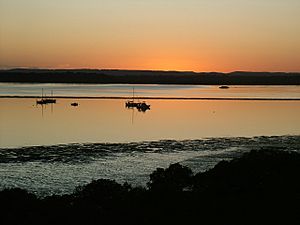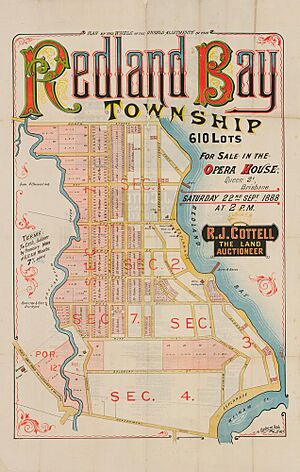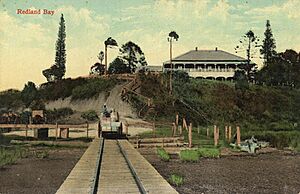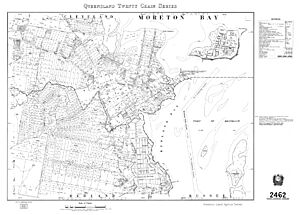Redland Bay, Queensland facts for kids
Quick facts for kids Redland BayRedland City, Queensland |
|||||||||||||||
|---|---|---|---|---|---|---|---|---|---|---|---|---|---|---|---|
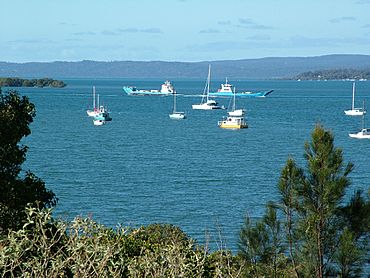
Redland Bay Passage featuring vehicular ferries servicing the Bay Islands
|
|||||||||||||||
| Population | 17,056 (2021 census) | ||||||||||||||
| • Density | 325.5/km2 (843/sq mi) | ||||||||||||||
| Postcode(s) | 4165 | ||||||||||||||
| Area | 52.4 km2 (20.2 sq mi) | ||||||||||||||
| Time zone | AEST (UTC+10:00) | ||||||||||||||
| Location |
|
||||||||||||||
| LGA(s) | Redland City | ||||||||||||||
| State electorate(s) | Redlands | ||||||||||||||
| Federal Division(s) | Bowman | ||||||||||||||
|
|||||||||||||||
Redland Bay is a coastal town in Queensland, Australia. It's part of Redland City. In 2021, about 17,056 people lived here.
For a long time, Redland Bay was mostly about farming and fishing. But in the mid-1900s, it started to grow. Now, many people live here and travel to Brisbane for work.
Contents
Exploring Redland Bay's Location
Redland Bay is in the southern part of Redland City. It's about 35 kilometers (22 miles) south-east of Brisbane. Brisbane is the capital city of Queensland.
The town gets its name from the beautiful bay to its east. This bay is part of the much bigger Moreton Bay.
The soil here is a special red color. This color comes from iron in lava. Millions of years ago, a volcano erupted about 100 kilometers (62 miles) south of here.
Redland Bay is a port for boats that travel to the nearby islands. These islands include Russell Island, Macleay Island, Karragarra Island, Lamb Island, and North Stradbroke Island. Thousands of people live on these islands.
A Look Back at Redland Bay's History
The Aboriginal name for this area is Talwalpin. This name comes from the cottonwood tree, which grew widely here.
Early Settlers and Farming Life
In the 1860s, settlers from England, Germany, and Scandinavia came to this area. They found thick forests with good soil. The soil in Redland Bay was especially rich. It had lush rainforests, including valuable red cedar trees.
Clearing the forest was very hard work. One person with an axe might take years to clear enough land for a farm. The cut timber was then used to build the first houses. Local cedar was used for doors and other special parts of early homes. The red soil even turned farm buildings a reddish color over time!
One early settler was Arnold Friedrich Muller. He started a farm of about 50 acres (20 hectares). His farmhouse is gone now, but two large fig trees mark where it used to be. These trees were planted around 1905. They remind us of the hard-working farming families who shaped Redland Bay. Arnold's oldest son, William, was born here in 1879. He was the first white person born in the area and lived to be 99 years old.
Early farms grew sugar cane, pineapples, and citrus fruits. Farmers first used horse-drawn wagons to take their crops to market. Later, steamboats like the Pearl and Louisa helped transport goods. Over time, Redland Bay farmers started growing tomatoes, cabbage, and passionfruit. This continued until around the year 2000.
Growth and Development
Redland Bay Provisional School opened on December 14, 1881. It was a "half-time" school, meaning one teacher taught at two schools. In 1890, it became Redland Bay State School.
In the 1880s, land was sold in Redland Bay. Advertisements promised great views and even a future railway line. However, the railway extension to Redland Bay was never built.
A Baptist church opened in Redland Bay in 1906. It was expanded and reopened in 1932.
In 1979, Redland Bay was still mostly farmland. But in the years that followed, the local council allowed more houses to be built. As land prices went up, farmers found it hard to compete. Many farms were sold to developers. By 2002, most farming in Redland Bay had stopped.
Since 2000, Redland Bay has grown a lot. Most farms have been replaced by houses, and the area now has its own shops. A new school, Scenic Shores State School, opened on January 22, 2024.
Redland Bay's Population
In 2011, Redland Bay had 13,624 people. About half were female and half were male. The average age was 37 years old. Most people (75.2%) were born in Australia. Other common birthplaces included England (7.6%) and New Zealand (5.2%). Most people (92.7%) spoke only English at home.
By 2016, the population grew to 14,958 people. In the most recent census in 2021, Redland Bay had 17,056 people living there.
Places of Historical Importance
Redland Bay has several sites that are important to its history. These are called heritage-listed sites:
- The Redland Bay War Memorial, including a Roll of Honour, at 46-72 Banana Street.
- Orange Grove Manor, a house with a special roof, at 189 School of Arts Road.
- The Redland Bay State School Residence at 125-141 Gordon Road.
- Large Moreton Bay Fig trees on Moores Road.
- The Serpentine Creek Road Cemetery at 398-408 Serpentine Creek Road.
Redland Bay Flying Boat Base
From 1953 to 1971, large planes called Qantas Empire Flying Boats used Redland Bay. These were mainly Sunderland flying boats. They traveled from Sydney all the way to the United Kingdom. From 1955, another airline, Ansett, also used flying boats from Redland Bay. They took tourists to Hayman Island in North Queensland.
The flying boat base was busiest in the 1950s. In July 1953, there were 105 commercial flying boat movements. After 1971, Qantas started using new Boeing 747 planes. These new planes could fly much further, making the flying boats less useful. The base finally closed in 1972.
The main building for the Flying Boat Base was at the jetty on Banana Street. This is near where the Bay Island ferry service is today. Passengers could wait at the Redland Bay Hotel while their flying boats were prepared for the next part of their journey.
Schools in Redland Bay
Redland Bay State School is a government primary school for students from Prep to Year 6. It's located at 125-141 Gordon Road. In 2017, the school had 876 students. It also has a special education program.
Scenic Shores State School is another government primary school. It's for students from Prep to Year 6 and is located at 350-372 Serpentine Creek Road. It opened in January 2024.
There are no secondary schools in Redland Bay itself. The closest government high school is Victoria Point State High School. It's in the nearby area of Victoria Point.
Community Services
The Redland City Council offers a mobile library service. This library on wheels visits Stradbroke Street, bringing books and resources to the community.



